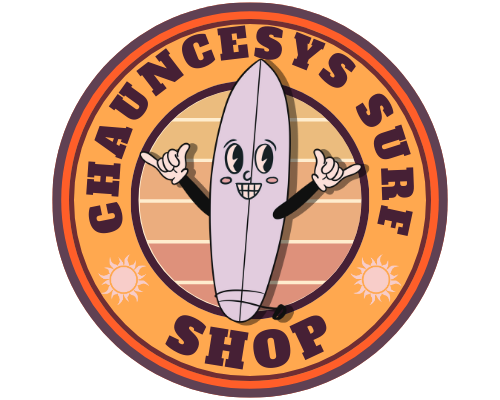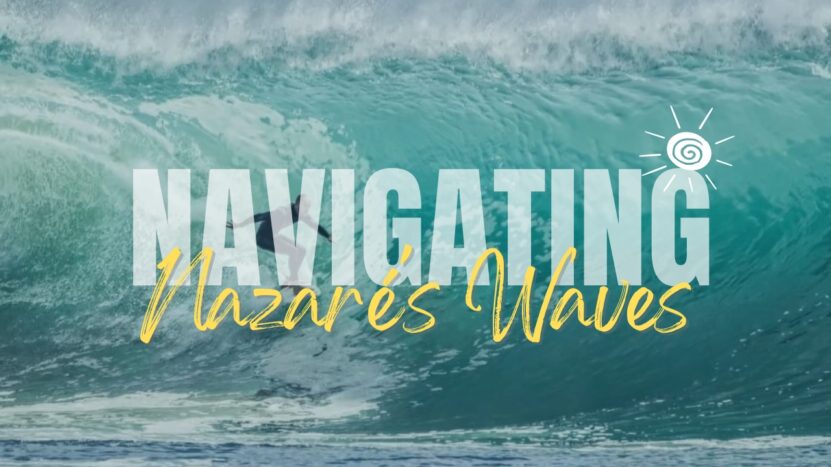I remember the first time I surfed Nazaré’s monster waves, the icy grip of fear, the adrenaline pumping through my veins, the exhilarating rush of riding a liquid mountain, and the immense respect for the power of the ocean that experience instilled in me. Nazaré isn’t just a surf spot; it’s a battle with nature, a dance on the edge of chaos, and a humbling testament to the wild, untamed spirit of the sea.
It’s no wonder that this location attracts surfers from all corners of the globe, lured by the legendary tales of massive swells and the promise of a ride of a lifetime. But can beginners surf in Nazaré? Should they? I’m going to dive into these questions, offering insights from my years of surfing, including my encounters with the giants of this lovely Portuguese town.
A Brief Introduction to the Town
Nazaré, a small fishing town located in Portugal, has become a staple in the surfing community for its monstrous waves, some even reaching over 100 feet. These massive water mountains are the result of a natural underwater canyon combined with perfect wind and swell directions.
Surfing enthusiasts worldwide dream of riding the mammoth waves of Nazaré, picturing themselves standing triumphant atop a liquid Everest. However, the challenge and risk of these waves are substantial, with the raw power of the ocean presenting a significant obstacle to even the most seasoned professionals.
Despite the awe and ambition Nazaré inspires, it’s essential to understand that this spot is anything but beginner-friendly. Remember, it’s not a sign of weakness to acknowledge the power and danger of the ocean. It’s a mark of respect and wisdom.
The Power of Nazaré
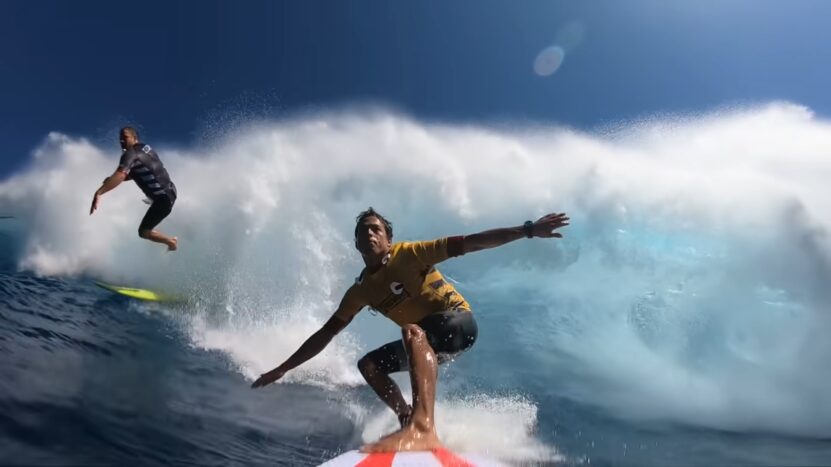
Nazaré’s waves are not only distinguished by their height but also by their power. A deep, offshore underwater canyon funnels the Atlantic’s raw energy into these colossal waves. This force is awe-inspiring and humbling, but it’s also dangerous, particularly to those unfamiliar with such conditions.
1. Speed
The underwater topography at Nazaré causes waves to move unusually fast. They break quickly and with an energy that can be challenging for even the most experienced surfers to manage.
2. Power
The power behind these waves is almost unimaginable. It’s not uncommon for experienced surfers to suffer injuries from the sheer force of the water.
3. Height
When the conditions are right, the waves can exceed 100 feet. The largest wave ever surfed was recorded here in 2020, measuring a mind-blowing 101.4 feet.
For a beginner, these factors make Nazaré a potentially life-threatening environment. While it may be enticing, understanding and respecting your limitations is a crucial part of the surfing journey.
Why Nazaré Isn’t Suitable for Beginners
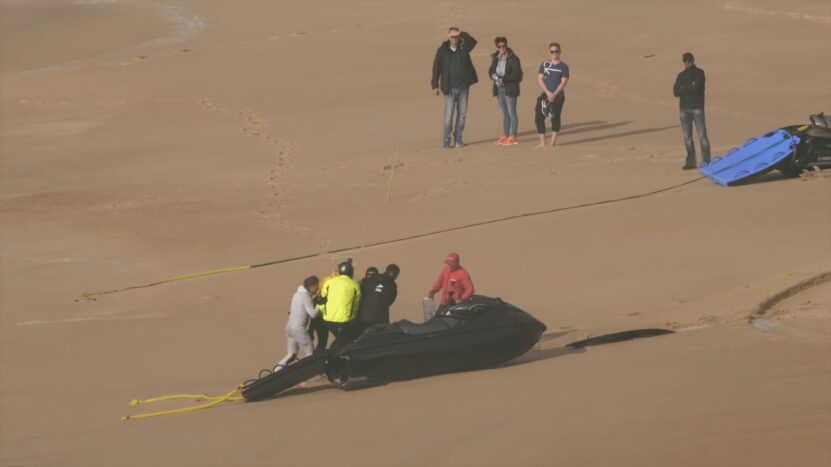
While there’s no denying the pull Nazaré may have for aspiring surfers, it’s crucial to consider the skills required to tackle this titan of a surf spot. Navigation, wave judgment, physical conditioning, and breath control – these are all aspects that even professional surfers continue to work on, and beginners typically lack the necessary competence in these areas.
When you’re starting, stick to beach breaks with smaller, consistent waves that allow you to build these skills gradually. Remember, surfing is a marathon, not a sprint, and everyone has their own pace. Start slow, learn effectively, and you’ll develop a stronger foundation for your future surfing adventures.
Furthermore, safety is paramount when surfing, and Nazaré’s waves, along with its strong rip currents, make for a hazardous environment. You’ll often see safety teams in the water during big wave sessions, a testament to the spot’s danger level.
Ideal Conditions for Beginner Surfers
So, what should beginners look for in a surf spot?
- Consistent, smaller waves: Learning the fundamentals of paddling, standing up, and maneuvering is easier on smaller, consistent waves.
- Sandy bottoms: Spots with sandy bottoms are typically safer for beginners as they minimize the risk of injury from hitting bottom.
- Crowd level: Less crowded spots are preferable. Not only can a crowded lineup be intimidating, but it also increases the risk of collisions.
Some surf schools and calm beach breaks in Portugal offer these conditions, allowing you to start your surfing journey safely and enjoyably.
The Path to Nazaré
While Nazaré might be off-limits now, it doesn’t mean it’s an unattainable dream. Many professionals who ride Nazaré’s waves today began on smaller, more manageable waves, gradually building their skills, strength, and confidence.
Progression in surfing isn’t linear, and everyone’s journey is unique. Some may spend years honing their skills before attempting bigger waves, while others may advance more quickly. Regardless of your pace, what matters is maintaining a commitment to learning and respect for the ocean.
Understand that it takes time to develop the necessary skills for big-wave surfing. You wouldn’t climb Everest without the right experience and equipment; approach Nazaré with the same mentality.
Training for Big Wave Surfing
Assuming that you’ve spent substantial time on your board and mastered the basics, how do you prepare for a beast like Nazaré?
- Physical Fitness: Big wave surfing demands superior physical strength, endurance, and flexibility. Regular cardiovascular exercises, strength training, and yoga can be beneficial.
- Breath Control: Free-diving courses can be a great way to improve your breath-holding ability and staying calm underwater.
- Wave Judgment: This comes with experience, but studying wave patterns and understanding how to navigate big waves is crucial.
- Safety Training: Learning about water safety, rescue procedures, and basic first aid are essential.
Always remember, proper training and preparation can make the difference between a thrilling ride and a dangerous wipeout.
Safety Measures at Nazaré
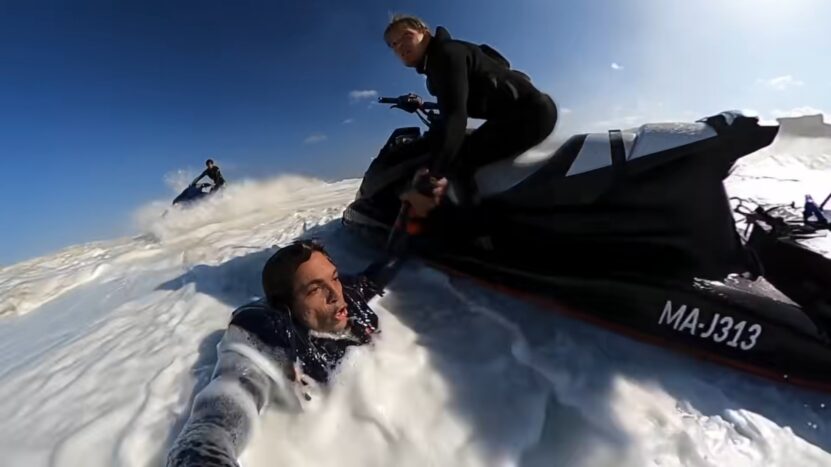
Even the pros don’t tackle Nazaré’s waves without proper safety measures. Here’s what the safety protocol looks like:
- Jet Ski Assistance: Jet skis are often used to tow surfers into the wave. They’re also crucial for rescuing surfers after a wipeout.
- Spotters: Spotters positioned on the cliffs help coordinate the surfers and jet ski drivers, guiding them away from dangerous zones.
- Inflatable Vests: These vests help surfers quickly return to the surface after being submerged by a wave.
- Teamwork: Surfers usually work in teams with experienced water safety professionals involved.
This level of safety protocol further highlights Nazaré’s potential danger and underscores why it’s not a suitable spot for beginners.
Nazaré’s Draw for Professionals
While Nazaré poses substantial challenges, it’s also a proving ground for professional surfers. The world’s best flock to this Portuguese town to test their limits against Mother Nature.
The thrill of riding these gargantuan waves, the camaraderie among surfers, and the sheer spectacle of the event draw in crowds and create a palpable energy. There’s something about confronting nature at its most raw and powerful that’s both humbling and electrifying.
But remember, these professionals have spent years, if not decades, building their skills, fitness, and experience to surf Nazaré safely and successfully.
Closing Thoughts
Every surfer’s journey is unique, filled with personal victories, wipeouts, and lessons. While the allure of Nazaré is undeniable, it’s crucial to respect the journey and understand that mastery comes with time, patience, and experience.
Start on smaller waves, learn the fundamentals, respect the ocean, and gradually push your limits. Remember, the best surfer is the one having the most fun. If you’re a beginner, there are plenty of other spots to start your journey that are just as beautiful and a lot less treacherous.
